
Up and Running with SQL
Introduction to databases
We do realise that most of the softwares around are designed to solve a problem!. To better understand what databases are ,we need to first understand the problems that necessitated the advent of databases. The answer to this is quite obvious ! you have some data or large amounts of information that you need to store, this data could be about:
But why worry? , we could store the data in text files or even spreadsheets or if they are documents we can just organise them in folders…. is it! . Just having data is not a good enough reason to have a database , having data is not the problem but the problem is what comes next. Below are some of the problems that a database can solve
so what`s a database?
What is a database?
A structured storage space where the data is kept in many tables and organized so that the necessary information can be easily fetched, manipulated, and summarized.
tables and fields
A table is an organized set of related data stored in a tabular form, i.e., in rows and columns. A field is another term for a column of a table and record is the other name for a row
Relational Data



To better understand this, let’s consider a scenario were Bongani Has a business. say I have a number of different restaurants. In one table I might have information about these restaurants including, where they are located and what type of food they serve. I may then have a second table where information about health and safety inspections is stored. Each inspection is a different row and the date of the inspection, the inspector, and the safety rating are stored in this table. Finally, I might have a third table. This third table contains information pulled from an API, regarding the number of stars given to each restaurant, as rated by people online. Each table contains different bits of information; however, there is a common column id in each of the tables. This allows the information to be linked between the tables. The restaurant with the id “JJ29JJ” in the restaurant table would refer to the same restaurant with the id “JJ29JJ” in the health inspections table, and so on. The values in this id column are known as unique identifiers because they uniquely identify each restaurant. No two restaurants will have the same id, and the same restaurant will always have the same id, no matter what table you’re looking at. The fact that these tables have unique identifiers connecting each table to all the other tables makes this example what we call relational data.
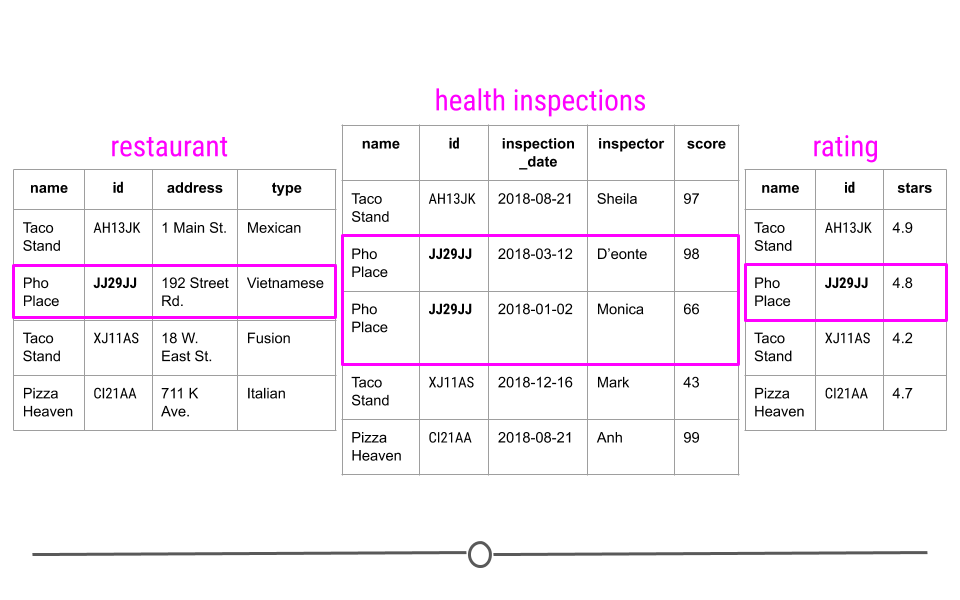
Why relational data?
Storing data in this way has a number of advantages; however, the three most important are:
- Efficient Data Storage
- Avoids Ambiguity
- Privacy
DBMS
DDMS stands for Database Management System, a software package used to perform various operations on the data stored in a database, such as accessing, updating, wrangling, inserting, and removing data. There are various types of DBMS, such as relational, hierarchical, network, graph, or object-oriented. These types are based on the way the data is organized, structured, and stored in the system.
RDBMS
RDBMS stands for Relational Database Management System. It’s the most common type of DBMS used for working with data stored in multiple tables related to each other by means of shared keys. The SQL programming language is particularly designed to interact with RDBMS. Some examples of RDBMS are MySQL, PostgreSQL, Oracle, MariaDB, etc.
SQL constraints
| constraints | Description |
|---|---|
| DEFAULT | provides a default value for a column |
| UNIQUE | allows only unique values |
| NOT NULL | allows only non-null values. |
| PRIMARY KEY | allows only unique and strictly non-null values (NOT NULL and UNIQUE). |
| FOREIGN KEY | provides shared keys between two and more tables |
unique key
A column (or multiple columns) of a table to which the UNIQUE constraint was imposed to ensure unique values in that column, including a possible NULL value (the only one).
foreign key
A column (or multiple columns) of a table to which the FOREIGN KEY constraint was imposed to link this column to the primary key in another table (or several tables). The purpose of foreign keys is to keep connected various tables of a database.
SQL queries
A query is a piece of code written in SQL to access the data from a database or to modify the data. Correspondingly, there are two types of SQL queries: select and action queries. The first ones are used to retrieve the necessary data (this also includes limiting, grouping, ordering the data, extracting the data from multiple tables, etc.), while the second ones are used to create, add, delete, update, rename the data, etc.
SQL comments
A human-readable clarification on what a particular piece of code does. SQL code comments can be single-line (preceded by a double dash –) or span over multiple lines (as follows: /comment_text/). When the SQL engine runs, it ignores code comments. The purpose of adding SQL code comments is to make the code more comprehensive for those people who will read it in the future.
types of SQL commands (or SQL subsets)
| Command | Explanation |
|---|---|
| Data Definition Language (DDL) | to define and modify the structure of a database. |
| Data Manipulation Language (DML) | to access, manipulate, and modify data in a database. |
| Data Control Language (DCL) | to control user access to the data in the database and give or, revoke privileges to a specific user or a group of users. |
| Transaction Control Language (TCL) | to control transactions in a database. |
| Data Query Language (DQL) | to perform queries on the data in a database to retrieve the necessary information from it. |
creating a table
any computer system that deals with storing data needs to have the four fundamental functions that have the ability to:
C-REATER-EADU-UPDATED-ELETE
commonly pronounced as CRUD
we use the
CREATE TABLEstatement.
CREATE TABLE table_name (col_1 datatype,
col_2 datatype,
col_3 datatype);for instance if run the following query !
CREATE TABLE my_table (age INTERGER,
sex TEXT);we add the values to the table using INSERT INTO .... VALUES (....)
INSERT INTO my_table VALUES (34,'male');
INSERT INTO my_table VALUES (47,'female');
INSERT INTO my_table VALUES (32,'male'); then call the database using SELECT
SELECT * FROM my_table;#> # A tibble: 3 × 2
#> age sex
#> <dbl> <chr>
#> 1 34 male
#> 2 47 female
#> 3 32 maleQuerying a database
- we will use the
Employee attrition database - A query is a request for data from a database table (or combination of tables).
- Querying is an essential skill for a data scientist, since the data you need for your analyses will often live in databases.
SELECT statement
select all with *
- In SQL, you can select data from a table using a SELECT statement. For example, the following query selects the name column from the people table:
SELECT name FROM people; - you may want to select all columns from a table use
*rather than typing all the columns
SELECT * FROM dat_new#> EmployeeNumber Attrition Age BusinessTravel DailyRate
#> 1 1 Yes 41 Travel_Rarely 1102
#> 2 2 No 49 Travel_Frequently 279
#> 3 4 Yes 37 Travel_Rarely 1373
#> 4 5 No 33 Travel_Frequently 1392
#> 5 7 No 27 Travel_Rarely 591
#> 6 8 No 32 Travel_Frequently 1005
#> 7 10 No 59 Travel_Rarely 1324
#> 8 11 No 30 Travel_Rarely 1358
#> 9 12 No 38 Travel_Frequently 216
#> 10 13 No 36 Travel_Rarely 1299
#> Department DistanceFromHome Education EducationField
#> 1 Sales 1 2 Life Sciences
#> 2 Research & Development 8 1 Life Sciences
#> 3 Research & Development 2 2 Other
#> 4 Research & Development 3 4 Life Sciences
#> 5 Research & Development 2 1 Medical
#> 6 Research & Development 2 2 Life Sciences
#> 7 Research & Development 3 3 Medical
#> 8 Research & Development 24 1 Life Sciences
#> 9 Research & Development 23 3 Life Sciences
#> 10 Research & Development 27 3 Medical
#> EmployeeCount EnvironmentSatisfaction Gender HourlyRate JobInvolvement
#> 1 1 2 Female 94 3
#> 2 1 3 Male 61 2
#> 3 1 4 Male 92 2
#> 4 1 4 Female 56 3
#> 5 1 1 Male 40 3
#> 6 1 4 Male 79 3
#> 7 1 3 Female 81 4
#> 8 1 4 Male 67 3
#> 9 1 4 Male 44 2
#> 10 1 3 Male 94 3
#> JobLevel JobRole JobSatisfaction MaritalStatus
#> 1 2 Sales Executive 4 Single
#> 2 2 Research Scientist 2 Married
#> 3 1 Laboratory Technician 3 Single
#> 4 1 Research Scientist 3 Married
#> 5 1 Laboratory Technician 2 Married
#> 6 1 Laboratory Technician 4 Single
#> 7 1 Laboratory Technician 1 Married
#> 8 1 Laboratory Technician 3 Divorced
#> 9 3 Manufacturing Director 3 Single
#> 10 2 Healthcare Representative 3 Married
#> MonthlyIncome MonthlyRate NumCompaniesWorked Over18 OverTime
#> 1 5993 19479 8 Y Yes
#> 2 5130 24907 1 Y No
#> 3 2090 2396 6 Y Yes
#> 4 2909 23159 1 Y Yes
#> 5 3468 16632 9 Y No
#> 6 3068 11864 0 Y No
#> 7 2670 9964 4 Y Yes
#> 8 2693 13335 1 Y No
#> 9 9526 8787 0 Y No
#> 10 5237 16577 6 Y No
#> PercentSalaryHike PerformanceRating RelationshipSatisfaction StandardHours
#> 1 11 3 1 80
#> 2 23 4 4 80
#> 3 15 3 2 80
#> 4 11 3 3 80
#> 5 12 3 4 80
#> 6 13 3 3 80
#> 7 20 4 1 80
#> 8 22 4 2 80
#> 9 21 4 2 80
#> 10 13 3 2 80
#> StockOptionLevel TotalWorkingYears TrainingTimesLastYear WorkLifeBalance
#> 1 0 8 0 1
#> 2 1 10 3 3
#> 3 0 7 3 3
#> 4 0 8 3 3
#> 5 1 6 3 3
#> 6 0 8 2 2
#> 7 3 12 3 2
#> 8 1 1 2 3
#> 9 0 10 2 3
#> 10 2 17 3 2
#> YearsAtCompany YearsInCurrentRole YearsSinceLastPromotion
#> 1 6 4 0
#> 2 10 7 1
#> 3 0 0 0
#> 4 8 7 3
#> 5 2 2 2
#> 6 7 7 3
#> 7 1 0 0
#> 8 1 0 0
#> 9 9 7 1
#> 10 7 7 7
#> YearsWithCurrManager
#> 1 5
#> 2 7
#> 3 0
#> 4 0
#> 5 2
#> 6 6
#> 7 0
#> 8 0
#> 9 8
#> 10 7selecting a subset
- you can achieve this by defining the columns to be selected e.g
SELECT col_1,col_2,col_3
FROM my_table;using the database we get
SELECT Attrition,Department,Education
FROM dat_new;#> Attrition Department Education
#> 1 Yes Sales 2
#> 2 No Research & Development 1
#> 3 Yes Research & Development 2
#> 4 No Research & Development 4
#> 5 No Research & Development 1
#> 6 No Research & Development 2
#> 7 No Research & Development 3
#> 8 No Research & Development 1
#> 9 No Research & Development 3
#> 10 No Research & Development 3select distinct items in SQL
- Often your results will include many duplicate values. If you want to select all the unique values from a column, you can use the DISTINCT keyword. for instance if you have the following database table:
#> # A tibble: 5 × 3
#> Name age sex
#> <chr> <dbl> <chr>
#> 1 Bongani 34 male
#> 2 Eliza 47 female
#> 3 Bongani 34 male
#> 4 Peter 27 male
#> 5 Fadzie 19 female- we can see that
Bonganihas been recorded twice in the dataset
SELECT DISTINCT name,age,sex
FROM database_table#> Name age sex
#> 1 Bongani 34 male
#> 2 Eliza 47 female
#> 3 Peter 27 male
#> 4 Fadzie 19 femalefiltering using WHERE in SQL
WHERE is a filtering clause
In SQL, the WHERE keyword allows you to filter based on both text and numeric values in a table. There are a few different comparison operators you can use:
You can build up your WHERE queries by combining multiple conditions with the AND keyword.
SELECT DISTINCT name,age,sex
FROM df
WHERE sex='male';#> Name age sex
#> 1 Bongani 34 male
#> 2 Peter 27 maleCOUNT and AS alias in SQL
- The COUNT statement lets you count then returning the number of rows in one or more columns.
- we use
ASto rename default name COUNT(*)tells you how many rows are in a table
SELECT COUNT(*) AS pple_count
FROM database_table;#> pple_count
#> 1 5- the above query calculates the number of rows in the data and finds
5 rows
we can use
COUNT(DISTINCT column)to get the number of unique rows
SELECT COUNT(DISTINCT name) AS unique_count
FROM database_table;#> unique_count
#> 1 4the query above will calculate rows with distinct names and finds them to be 4
We can use COUNT with WHERE
- We can do this to get the number of terms after filtering
- how many people are male?
SELECT COUNT(*) AS num_male
FROM database_table
WHERE sex='male';#> num_male
#> 1 3Manipulating and Aggregating
Create a database for the exercises
con<-dbConnect(RSQLite::SQLite(), ":memory:")
copy_to(con,data1)
copy_to(con,data2)filtering using WHERE in SQL
the following points were outlined previously
WHERE is a filtering clause
In SQL, the WHERE keyword allows you to filter based on both text and numeric values in a table. There are a few different comparison operators you can use:
= equal
<> not equal
< less than
> greater than
<= less than or equal to
>= greater than or equal to
You can build up your WHERE queries by combining multiple conditions with the AND keyword.
SELECT *
FROM data2
WHERE category='Potato'| recipe | calories | sugar | protein | category |
|---|---|---|---|---|
| 624 | 236.62 | 0.81 | 9.07 | Potato |
filtering using IN and WHERE in SQL
SELECT *
FROM data2
WHERE category IN ('Chicken','Chicken Breast')| recipe | calories | sugar | protein | category |
|---|---|---|---|---|
| 609 | NA | NA | NA | Chicken Breast |
| 671 | 481.88 | 1.34 | 51.90 | Chicken |
| 683 | 147.24 | 0.94 | 54.00 | Chicken |
| 419 | 1830.28 | 1.83 | 44.74 | Chicken Breast |
| 117 | NA | NA | NA | Chicken Breast |
COUNT and AS alias in SQL
- The COUNT statement lets you count then returning the number of rows in one or more columns.
- we use
ASto rename default name COUNT(*)tells you how many rows are in a table
SELECT COUNT(*) AS n
FROM data2| n |
|---|
| 25 |
count filters in SQL
SELECT COUNT(category) AS n_potato
FROM data2
WHERE category IN ('Chicken Breast','Chicken')| n_potato |
|---|
| 5 |
Updating a database using dbExecute
- categories before
#> category n percent
#> Beverages 1 0.04
#> Breakfast 4 0.16
#> Chicken 2 0.08
#> Chicken Breast 3 0.12
#> Dessert 3 0.12
#> Meat 4 0.16
#> One Dish Meal 3 0.12
#> Pork 1 0.04
#> Potato 1 0.04
#> Vegetable 3 0.12Updating a database
- we need to change a category called
BreakfasttoBreakfast meal - we shall use
REPLACE
UPDATE data2
SET category= REPLACE(category,'Breakfast','Breakfast meal')
WHERE category='Breakfast'Querying to check results
SELECT category, COUNT(category) as n_per_category
FROM data2
GROUP BY category| category | n_per_category |
|---|---|
| Beverages | 1 |
| Breakfast meal | 4 |
| Chicken | 2 |
| Chicken Breast | 3 |
| Dessert | 3 |
| Meat | 4 |
| One Dish Meal | 3 |
| Pork | 1 |
| Potato | 1 |
| Vegetable | 3 |
- we see that
Breakfasthas updated toBreakfast meal
Missing data in SQL
- in SQL,
NULLrepresents a missing or unknown value. You can check for NULL values using the expression IS NULL - Use
IS NULLANDIS NOT NULL
filtering missing data
SELECT *
FROM data2
WHERE Protein IS NULL| recipe | calories | sugar | protein | category |
|---|---|---|---|---|
| 912 | NA | NA | NA | Dessert |
| 609 | NA | NA | NA | Chicken Breast |
| 117 | NA | NA | NA | Chicken Breast |
filtering nonmissing data
SELECT *
FROM data2
WHERE Protein IS NOT NULL| recipe | calories | sugar | protein | category |
|---|---|---|---|---|
| 624 | 236.62 | 0.81 | 9.07 | Potato |
| 102 | 198.98 | 0.39 | 39.12 | Vegetable |
| 427 | 187.41 | 86.97 | 4.49 | Dessert |
| 324 | 49.50 | 4.69 | 53.33 | Breakfast meal |
| 380 | 75.89 | 8.18 | 17.64 | Meat |
| 671 | 481.88 | 1.34 | 51.90 | Chicken |
| 683 | 147.24 | 0.94 | 54.00 | Chicken |
| 208 | 20.98 | 9.80 | 0.82 | Beverages |
| 633 | 105.95 | 0.07 | 7.55 | Vegetable |
| 859 | 388.44 | 4.62 | 13.93 | Pork |
How many categories do we have
select distinct items in SQL
- Often your results will include many duplicate values. If you want to select all the unique values from a column, you can use the DISTINCT keyword.
SELECT COUNT(DISTINCT category) AS unique_categories
FROM data2| unique_categories |
|---|
| 10 |
Advanced filters
filtering in SQL
SELECT *
FROM data2 WHERE sugar > 1 AND sugar < 5
AND category='Breakfast meal'| recipe | calories | sugar | protein | category |
|---|---|---|---|---|
| 324 | 49.5 | 4.69 | 53.33 | Breakfast meal |
| 598 | 212.4 | 2.25 | 23.78 | Breakfast meal |
| 526 | 93.5 | 2.57 | 23.68 | Breakfast meal |
- also achieved by using
BETWEENandAND
SELECT *
FROM data2
WHERE sugar BETWEEN 1 AND 5
AND category='Breakfast meal'| recipe | calories | sugar | protein | category |
|---|---|---|---|---|
| 324 | 49.5 | 4.69 | 53.33 | Breakfast meal |
| 598 | 212.4 | 2.25 | 23.78 | Breakfast meal |
| 526 | 93.5 | 2.57 | 23.68 | Breakfast meal |
filtering text data in SQL
- use
LIKE - the
LIKEoperator can be used in a WHERE clause to search for a pattern in a column. - To accomplish this, you use something called a wildcard as a placeholder for some other values. There are two wildcards you can use with LIKE:
The
%wildcard will match zero, one, or many characters in text
The
_wildcard will match a single character
SELECT *
FROM data2
WHERE category LIKE 'Chicken%'| recipe | calories | sugar | protein | category |
|---|---|---|---|---|
| 609 | NA | NA | NA | Chicken Breast |
| 671 | 481.88 | 1.34 | 51.90 | Chicken |
| 683 | 147.24 | 0.94 | 54.00 | Chicken |
| 419 | 1830.28 | 1.83 | 44.74 | Chicken Breast |
| 117 | NA | NA | NA | Chicken Breast |
Aggregate functions in SQL
SELECT AVG(sugar) AS avg_sugar,
MAX(sugar) AS max_sugar,
MIN(sugar) AS min_sugar,
VARIANCE(sugar) AS variance,
STDEV(sugar) AS stnd_deviation
FROM data2;| avg_sugar | max_sugar | min_sugar | variance | stnd_deviation |
|---|---|---|---|---|
| 11.24864 | 86.97 | 0.07 | 426.5449 | 20.65296 |
Grouping and aggregating in SQL
SELECT category,AVG(sugar) AS avg_sugar,
MAX(sugar) AS max_sugar,
MIN(sugar) AS min_sugar
FROM data2
GROUP BY category;| category | avg_sugar | max_sugar | min_sugar |
|---|---|---|---|
| Beverages | 9.8000000 | 9.80 | 9.80 |
| Breakfast meal | 5.1600000 | 11.13 | 2.25 |
| Chicken | 1.1400000 | 1.34 | 0.94 |
| Chicken Breast | 1.8300000 | 1.83 | 1.83 |
| Dessert | 69.5700000 | 86.97 | 52.17 |
| Meat | 13.5525000 | 30.06 | 5.21 |
| One Dish Meal | 3.9066667 | 6.09 | 1.46 |
| Pork | 4.6200000 | 4.62 | 4.62 |
| Potato | 0.8100000 | 0.81 | 0.81 |
| Vegetable | 0.8066667 | 1.96 | 0.07 |
we can order the data by a certain column using
ORDER BYclause
SELECT category,AVG(sugar) AS avg_sugar,
MAX(sugar) AS max_sugar,
MIN(sugar) AS min_sugar
FROM data2
GROUP BY category
ORDER BY avg_sugar;| category | avg_sugar | max_sugar | min_sugar |
|---|---|---|---|
| Vegetable | 0.8066667 | 1.96 | 0.07 |
| Potato | 0.8100000 | 0.81 | 0.81 |
| Chicken | 1.1400000 | 1.34 | 0.94 |
| Chicken Breast | 1.8300000 | 1.83 | 1.83 |
| One Dish Meal | 3.9066667 | 6.09 | 1.46 |
| Pork | 4.6200000 | 4.62 | 4.62 |
| Breakfast meal | 5.1600000 | 11.13 | 2.25 |
| Beverages | 9.8000000 | 9.80 | 9.80 |
| Meat | 13.5525000 | 30.06 | 5.21 |
| Dessert | 69.5700000 | 86.97 | 52.17 |
the above output shows results arranged in ascending order of
avg_sugar, if we needed to begin with the largest descending we could useORDER BY...DESC
SELECT category,AVG(sugar) AS avg_sugar,
MAX(sugar) AS max_sugar,
MIN(sugar) AS min_sugar
FROM data2
GROUP BY category
ORDER BY avg_sugar DESC;| category | avg_sugar | max_sugar | min_sugar |
|---|---|---|---|
| Dessert | 69.5700000 | 86.97 | 52.17 |
| Meat | 13.5525000 | 30.06 | 5.21 |
| Beverages | 9.8000000 | 9.80 | 9.80 |
| Breakfast meal | 5.1600000 | 11.13 | 2.25 |
| Pork | 4.6200000 | 4.62 | 4.62 |
| One Dish Meal | 3.9066667 | 6.09 | 1.46 |
| Chicken Breast | 1.8300000 | 1.83 | 1.83 |
| Chicken | 1.1400000 | 1.34 | 0.94 |
| Potato | 0.8100000 | 0.81 | 0.81 |
| Vegetable | 0.8066667 | 1.96 | 0.07 |
Using UPPER()
Sometimes you may want to change a column to all upper cases
SELECT recipe,category , UPPER(category) AS upper_cat
FROM data2;| recipe | category | upper_cat |
|---|---|---|
| 624 | Potato | POTATO |
| 102 | Vegetable | VEGETABLE |
| 427 | Dessert | DESSERT |
| 324 | Breakfast meal | BREAKFAST MEAL |
| 912 | Dessert | DESSERT |
| 380 | Meat | MEAT |
| 609 | Chicken Breast | CHICKEN BREAST |
| 671 | Chicken | CHICKEN |
| 683 | Chicken | CHICKEN |
| 208 | Beverages | BEVERAGES |
Basic arithmetic
- In addition to using aggregate functions, you can perform basic arithmetic with symbols like
+, -, *, and /. - lets create weird variables here
SELECT category,(sugar-protein) AS diff_sugar_protein
FROM data2;| category | diff_sugar_protein |
|---|---|
| Potato | -8.26 |
| Vegetable | -38.73 |
| Dessert | 82.48 |
| Breakfast meal | -48.64 |
| Dessert | NA |
| Meat | -9.46 |
| Chicken Breast | NA |
| Chicken | -50.56 |
| Chicken | -53.06 |
| Beverages | 8.98 |
CASE statements
this contains a
WHEN,THENandELSEstatement ,finished withEND
Take the stair CASE
- using
CASE WHENto categorise or group data as follows SELECT….CASE WHENconditionTHENcategoryWHENconditionTHENcategory- …………………………………..
ELSEsome_categoryEND ASvariable name
SELECT recipe , sugar,
CASE WHEN sugar BETWEEN 0 AND 50 THEN '0-50'
WHEN sugar BETWEEN 51 AND 100 THEN '51-100'
WHEN sugar BETWEEN 101 AND 200 THEN '101-200'
WHEN sugar IS NULL THEN 'missing'
ELSE '>200'
END AS sugar_category
FROM data2;| recipe | sugar | sugar_category |
|---|---|---|
| 624 | 0.81 | 0-50 |
| 102 | 0.39 | 0-50 |
| 427 | 86.97 | 51-100 |
| 324 | 4.69 | 0-50 |
| 912 | NA | missing |
| 380 | 8.18 | 0-50 |
| 609 | NA | missing |
| 671 | 1.34 | 0-50 |
| 683 | 0.94 | 0-50 |
| 208 | 9.80 | 0-50 |
we can letter perform aggregations on the new column for instance get the count per each category
SELECT COUNT(*) AS count_per_category,
CASE WHEN sugar BETWEEN 0 AND 50 THEN '0-50'
WHEN sugar BETWEEN 51 AND 100 THEN '51-100'
WHEN sugar BETWEEN 101 AND 200 THEN '101-200'
WHEN sugar IS NULL THEN 'missing'
ELSE '>200'
END AS sugar_category
FROM data2
GROUP BY sugar_category;| count_per_category | sugar_category |
|---|---|
| 20 | 0-50 |
| 2 | 51-100 |
| 3 | missing |
SQL subqueries
A subquery is a query nested in another query and is useful for intermediate transformations
SELECT column
FROM (SELECT column
FROM table) AS subquery;subqueries can be found anywhere within
SELECT,FROM,WHERE,GROUP BY
use cases
for instance
- use data1 and data2 databases for this task
- the following is just an example and calories in data2 and data1 are the same so the result is the same
SELECT recipe,calories
FROM data2
WHERE calories >
(SELECT AVG(calories) FROM data1);| recipe | calories |
|---|---|
| 671 | 481.88 |
| 859 | 388.44 |
| 171 | 431.28 |
| 282 | 409.99 |
| 91 | 388.37 |
| 868 | 307.36 |
| 885 | 504.09 |
| 419 | 1830.28 |
| 639 | 321.95 |
Summarize group statistics using subqueries
Sometimes you want to understand how a value varies across groups. For example, how does the maximum value per group vary across groups?
To find out, first summarize by group, and then compute summary statistics of the group results. One way to do this is to compute group values in a subquery, and then summarize the results of the subquery.
what is the standard deviation across meal cateries in the maximum amount of sugar? What about the mean, min, and max of the maximums as well?
Start by writing a subquery to compute the
max()per categoy; alias the subquery result as sugar_max. Then compute the standard deviation of sugar_max withstddev(). Compute themin(),max(), andavg()of sugar_max too.
SELECT AVG(sugar_max) AS avg_sugar,
MAX(sugar_max) AS max_sugar,
MIN(sugar_max) AS min_sugar,
VARIANCE(sugar_max) AS variance,
STDEV(sugar_max) AS stnd_deviation
FROM (SELECT MAX(sugar) AS sugar_max
FROM data2
-- Compute max by...
GROUP BY category) AS max_results| avg_sugar | max_sugar | min_sugar | variance | stnd_deviation |
|---|---|---|---|---|
| 15.461 | 86.97 | 0.81 | 707.2168 | 26.59355 |
SQL JOINS
setting up the data
- to aid with illustrations , I have created some
fake datasetsto assist in explaining and these arejoin_df1.csvandjoin_df2.csvdatasets - read in CSV files and store them as databases in R
# read in example csv files (join_df1 and join_df2)
join_df1 <- read.csv("join_df1.csv") |>
dplyr::rename(A=bongi)
join_df2 <- read.csv("join_df2.csv")|>
dplyr::rename(A=bongi)
join<-dbConnect(RSQLite::SQLite(), ":memory:")
copy_to(join,join_df1)
copy_to(join,join_df2)join_df1
SELECT * FROM join_df1| A | B | C |
|---|---|---|
| red | 2 | 3 |
| orange | 4 | 6 |
| yellow | 8 | 9 |
| green | 0 | 0 |
| indigo | 3 | 3 |
| blue | 1 | 1 |
| purple | 5 | 5 |
| white | 8 | 2 |
this data has 8 rows and 3 columns
join_df2
SELECT * FROM join_df2| A | D |
|---|---|
| red | 3 |
| orange | 5 |
| yellow | 7 |
| green | 1 |
| indigo | 3 |
| blue | 6 |
| pink | 9 |
this has 7 rows and 2 columns
- note that we will use the column
Aas ourunique identifier
Querying A join
generally the following step show how a join is done in SQL
SELECTt1.comon_column1,t1.common_column2,…FROMtable1ASt1<type> JOINtable2ASt2ONt1.common_unique_column = t2.common_unique_column;
Inner Join
When talking about inner joins, we are only going to keep an observation if it is found in all of the tables we’re combining. Here, we’re combining the tables based on the ArtistId column. In our dummy example, there are only two artists that are found in both tables. These are highlighted in green and will be the rows used to join the two tables. Then, once the inner join happens, only these artists’ data will be included after the inner join.

when doing an inner join, data from any observation found in all the tables being joined are included in the output. Here, ArtistIds “1” and “2” are in both the artists and albums tables. Thus, those will be the only ArtistIds in the output from the inner join.
And, since it’s a mutating join, our new table will have information from both tables! We now have ArtistId, Name, AlbumId, and Title in a single table! We’ve joined the two tables, based on the column ArtistId!
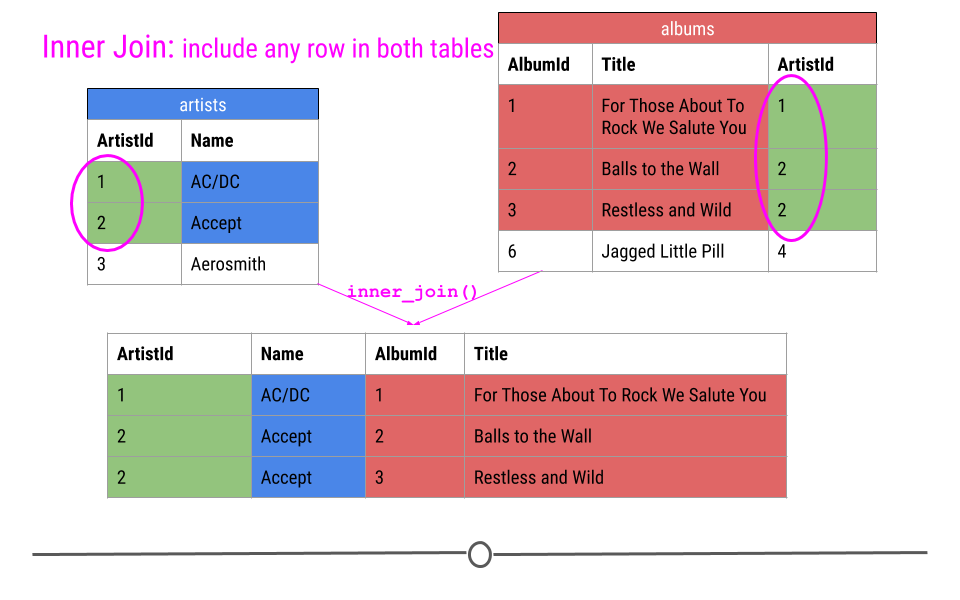
See this in ACTION
SELECT *
FROM join_df1
INNER JOIN join_df2
USING(A)| A | B | C | D |
|---|---|---|---|
| red | 2 | 3 | 3 |
| orange | 4 | 6 | 5 |
| yellow | 8 | 9 | 7 |
| green | 0 | 0 | 1 |
| indigo | 3 | 3 | 3 |
| blue | 1 | 1 | 6 |
we note from the above that only
the coloursthat arecommon to both tablesare returned. however instead of usingUSINGwe can useON table1.columnname=table2.columnnamewherecolumnnameis the column that tables to be matched by and in our example this is columnA. when using this method it is important to give each table anALIASwhich is ashorthandfor our tables
SELECT *
FROM join_df1 AS j1
INNER JOIN join_df2 AS j2
ON j1.A=j2.A; | A | B | C | A | D |
|---|---|---|---|---|
| red | 2 | 3 | red | 3 |
| orange | 4 | 6 | orange | 5 |
| yellow | 8 | 9 | yellow | 7 |
| green | 0 | 0 | green | 1 |
| indigo | 3 | 3 | indigo | 3 |
| blue | 1 | 1 | blue | 6 |
looking at the table above ,we note that
column Ahas been repeated twice , thus we need to onlySELECTthecolumn AFrom only one of our tables hence we specify the repeated columns in theSELECTstatement using thetable.columnnamemethod . So in the example aboveSELECT j1.A,B,C,Dspecifies that we want we want columnAto come from tablej1(j1.A)
SELECT j1.A,B,C,D
FROM join_df1 AS j1
INNER JOIN join_df2 AS j2
ON j1.A=j2.A;| A | B | C | D |
|---|---|---|---|
| red | 2 | 3 | 3 |
| orange | 4 | 6 | 5 |
| yellow | 8 | 9 | 7 |
| green | 0 | 0 | 1 |
| indigo | 3 | 3 | 3 |
| blue | 1 | 1 | 6 |
great :)! , generally we can apply the same scenario to all kinds of joins
left join in SQL
For a left join, all rows in the first table specified will be included in the output. Any row in the second table that is not in the first table will not be included.
In our toy example this means that ArtistIDs 1, 2, and 3 will be included in the output; however, ArtistID 4 will not.
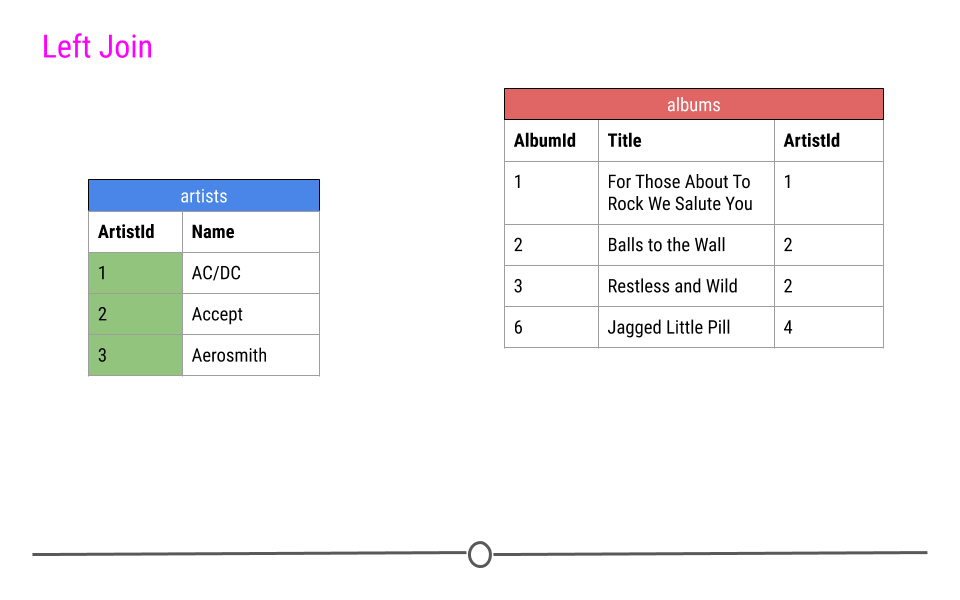
Thus, our output will again include all the columns from both tables combined into a single table; however, for ArtistId 3, there will be NAs for AlbumId and Title. NAs will be filled in for any observations in the first table specified that are missing in the second table.
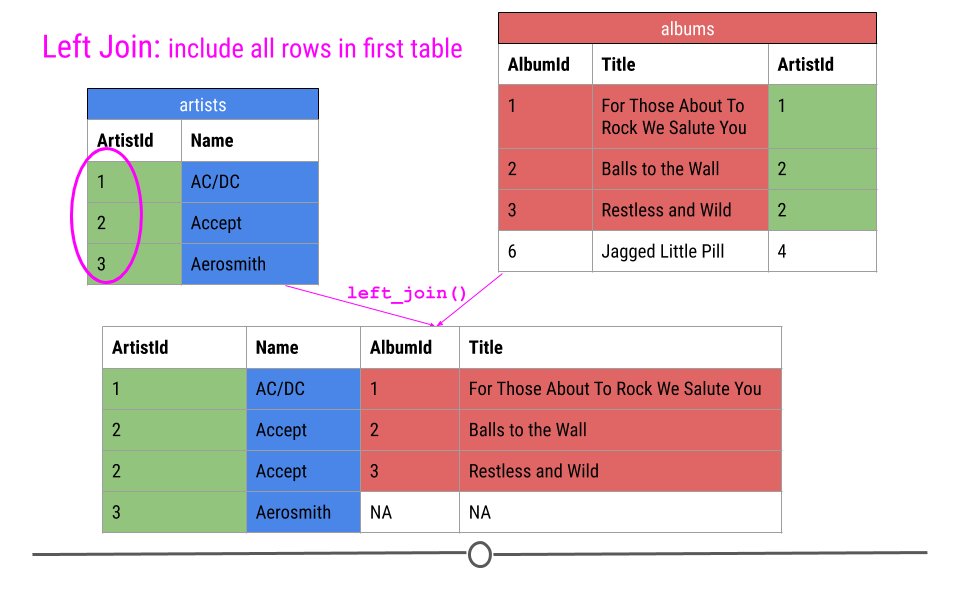
Let us see it in ACTION
SELECT j1.A,B,C,D
FROM join_df1 AS j1
LEFT JOIN join_df2 AS j2
ON j1.A=j2.A;| A | B | C | D |
|---|---|---|---|
| red | 2 | 3 | 3 |
| orange | 4 | 6 | 5 |
| yellow | 8 | 9 | 7 |
| green | 0 | 0 | 1 |
| indigo | 3 | 3 | 3 |
| blue | 1 | 1 | 6 |
| purple | 5 | 5 | NA |
| white | 8 | 2 | NA |
great , we notice the
NAvalues found in the last column
RIGHT JOIN IN SQL
Right Join is similar to what we just discussed; however, in the output from a right join, all rows in the final table specified are included in the output. NAs will be included for any observations found in the last specified table but not in the other tables.
In our toy example, that means, information about ArtistIDs 1, 2, and 4 will be included.
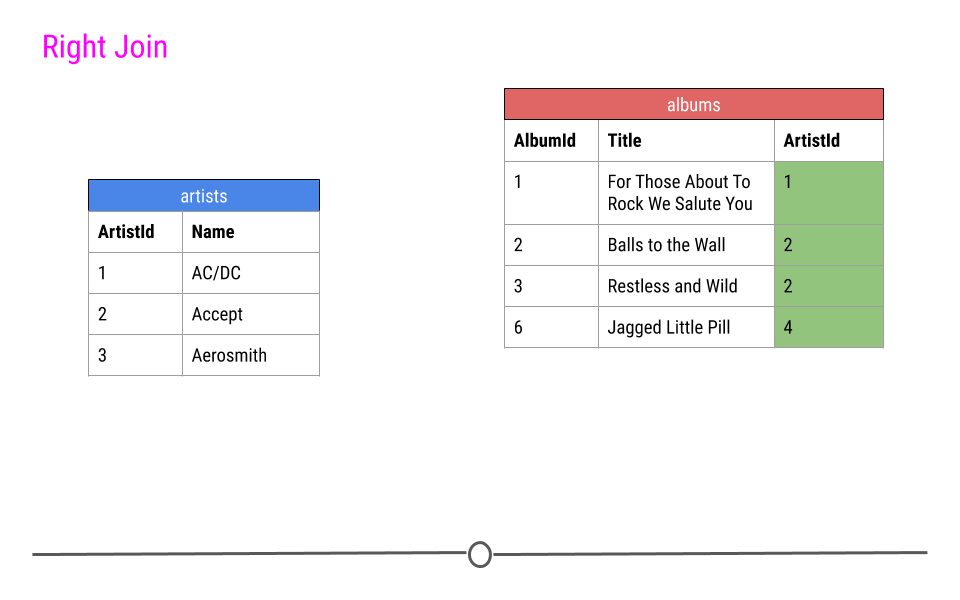
Again, in our toy example, we see that right join combines the information across tables; however, in this case, ArtistId 4 is included, but Name is an NA, as this information was not in the artists table for this artist.
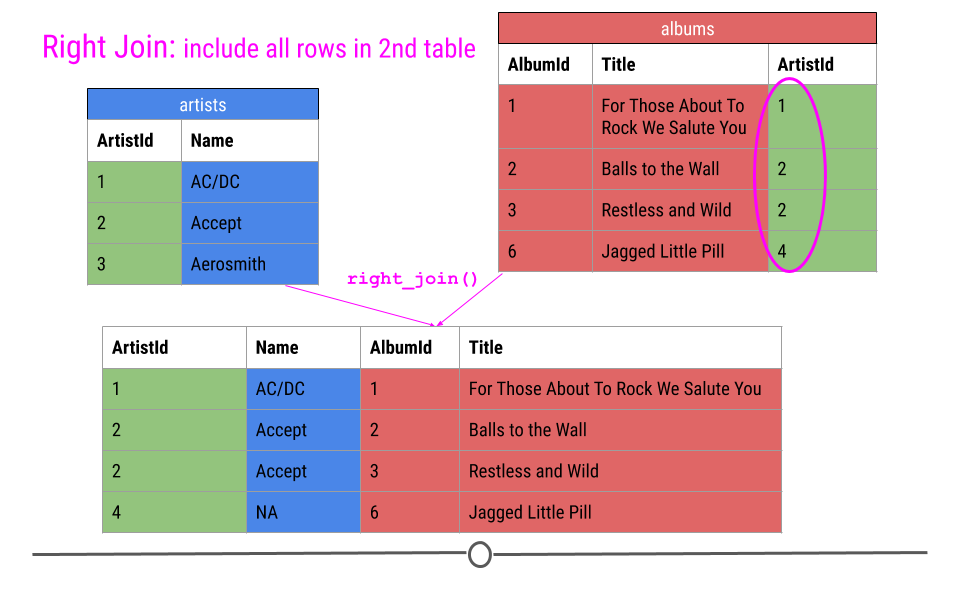
Let us see a
RIGHT JOINin action
SELECT j1.A,B,C,D
FROM join_df1 AS j1
RIGHT JOIN join_df2 AS j2
ON j1.A=j2.A;| A | B | C | D |
|---|---|---|---|
| red | 2 | 3 | 3 |
| orange | 4 | 6 | 5 |
| yellow | 8 | 9 | 7 |
| green | 0 | 0 | 1 |
| indigo | 3 | 3 | 3 |
| blue | 1 | 1 | 6 |
| NA | NA | NA | 9 |
great , notice now where the
NAis displayed
full join in SQL
Finally, a full join will take every observation from every table and include it in the output.
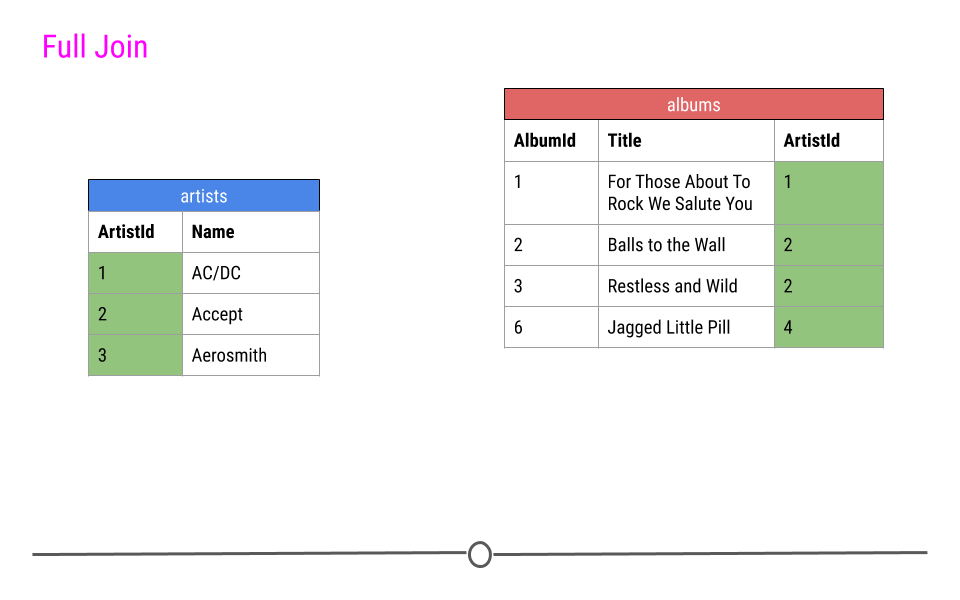
Thus, in our toy example, this join produces five rows, including all the observations from either table. NAs are filled in when data are missing for an observation.
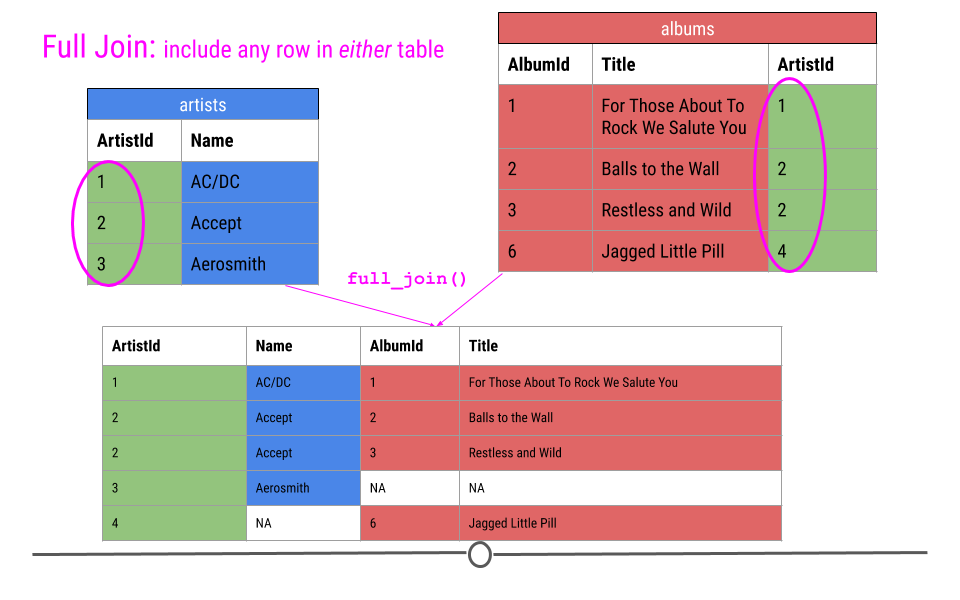
let us see a
FULL JOINin ACTION
SELECT j1.A,B,C,D
FROM join_df1 AS j1
FULL JOIN join_df2 AS j2
ON j1.A=j2.A;| A | B | C | D |
|---|---|---|---|
| red | 2 | 3 | 3 |
| orange | 4 | 6 | 5 |
| yellow | 8 | 9 | 7 |
| green | 0 | 0 | 1 |
| indigo | 3 | 3 | 3 |
| blue | 1 | 1 | 6 |
| purple | 5 | 5 | NA |
| white | 8 | 2 | NA |
| NA | NA | NA | 9 |
Window functions
- A window function performs an aggregate-like operation on a set of query rows.
However, whereas an aggregate operation groups query rows into a single result row, a window function produces a result for each query row:
Anatomy of a window function
FUNCTION_NAME() OVER()ORDER BYPARTITION BYROWS/RANGE PRECEDING/FOLLOWING/UNBOUNDED
Creating a fake dataset in R
library(tidyverse)
sales<-tribble(~ year , ~country , ~product , ~profit ,~Own ,~Time,
2000 , "Finland", "Computer" , 1500 ,"Y" ,"D",
2000 , "Finland" ,"Phone" , 100 ,"Y" ,"D",
2001 , "Finland" ,"Phone" , 10 ,"N" ,"D",
2000 , "India" ,"Calculator" , 75 ,"Y" ,"E",
2000 , "India" ,"Calculator" , 75 ,"N" ,"E",
2000 , "India" ,"Computer" , 1200 ,"N" ,"E",
2000 , "USA" , "Calculator", 75 ,"Y" ,"E",
2000 , "USA" , "Computer" , 1500 ,"N" ,"E",
2001 , "USA" ,"Calculator" , 50 ,"Y" ,"E",
2001 , "USA" ,"Computer" , 1500 ,"Y" ,"E",
2001 , "USA" ,"Computer" , 1200 ,"Y" ,"D",
2001 , "USA" , "TV" , 150 ,"Y" ,"D",
2001 , "USA" , "TV" , 100 ,"Y" ,"D")
sales
#> # A tibble: 13 × 6
#> year country product profit Own Time
#> <dbl> <chr> <chr> <dbl> <chr> <chr>
#> 1 2000 Finland Computer 1500 Y D
#> 2 2000 Finland Phone 100 Y D
#> 3 2001 Finland Phone 10 N D
#> 4 2000 India Calculator 75 Y E
#> 5 2000 India Calculator 75 N E
#> 6 2000 India Computer 1200 N E
#> 7 2000 USA Calculator 75 Y E
#> 8 2000 USA Computer 1500 N E
#> 9 2001 USA Calculator 50 Y E
#> 10 2001 USA Computer 1500 Y E
#> 11 2001 USA Computer 1200 Y D
#> 12 2001 USA TV 150 Y D
#> 13 2001 USA TV 100 Y DLoad in the necessary packages
library(odbc)
library(DBI)
library(RSQLite)Set up a database using the datafile
wind<-dbConnect(RSQLite::SQLite(), ":memory:")
copy_to(wind,sales)Lets get started
- The row for which function evaluation occurs is called the current row.
- The query rows related to the current row over which function evaluation occurs comprise the window for the current row.
ROW_NUMBER() OVER()
- use it if maybe you have duplicates or intend to create rowids for your data
SELECT ROW_NUMBER() OVER () AS row_id , year, country, product, profit
FROM sales;| row_id | year | country | product | profit |
|---|---|---|---|---|
| 1 | 2000 | Finland | Computer | 1500 |
| 2 | 2000 | Finland | Phone | 100 |
| 3 | 2001 | Finland | Phone | 10 |
| 4 | 2000 | India | Calculator | 75 |
| 5 | 2000 | India | Calculator | 75 |
| 6 | 2000 | India | Computer | 1200 |
| 7 | 2000 | USA | Calculator | 75 |
| 8 | 2000 | USA | Computer | 1500 |
| 9 | 2001 | USA | Calculator | 50 |
| 10 | 2001 | USA | Computer | 1500 |
PARTITION BY
- This splits the table into
partitionsbased on a column’s unique values and results aren’t rolled into one column
therefore
ROW_NUMBER()WithPARTITION BYproduces the row number of each row within its partition. In this case, rows are numbered per country. By default, partition rows are unordered and row numbering is nondeterministic.
SELECT ROW_NUMBER() OVER(PARTITION BY country) AS row_num1,
year, country, product, profit
FROM sales;| row_num1 | year | country | product | profit |
|---|---|---|---|---|
| 1 | 2000 | Finland | Computer | 1500 |
| 2 | 2000 | Finland | Phone | 100 |
| 3 | 2001 | Finland | Phone | 10 |
| 1 | 2000 | India | Calculator | 75 |
| 2 | 2000 | India | Calculator | 75 |
| 3 | 2000 | India | Computer | 1200 |
| 1 | 2000 | USA | Calculator | 75 |
| 2 | 2000 | USA | Computer | 1500 |
| 3 | 2001 | USA | Calculator | 50 |
| 4 | 2001 | USA | Computer | 1500 |
its also possible to use
ROW_NUMBER()WithORDER BYto determine ranks
SELECT ROW_NUMBER() OVER(ORDER BY profit DESC) AS row_num1,
year, country, product, profit
FROM sales;| row_num1 | year | country | product | profit |
|---|---|---|---|---|
| 1 | 2000 | Finland | Computer | 1500 |
| 2 | 2000 | USA | Computer | 1500 |
| 3 | 2001 | USA | Computer | 1500 |
| 4 | 2000 | India | Computer | 1200 |
| 5 | 2001 | USA | Computer | 1200 |
| 6 | 2001 | USA | TV | 150 |
| 7 | 2000 | Finland | Phone | 100 |
| 8 | 2001 | USA | TV | 100 |
| 9 | 2000 | India | Calculator | 75 |
| 10 | 2000 | India | Calculator | 75 |
in the above example , we see that we have ranked our data according to
profitsimplying that each rowid also signifies the rank of profit
RANK()
- ROW_NUMBER assigns different numbers to profits with the same amount, so it’s not a useful ranking function; if profits are the same , they should have the same rank.
in such a case we use
RANK()
SELECT RANK() OVER(ORDER BY profit DESC) AS RANK,
profit ,year, country, product
FROM sales;| RANK | profit | year | country | product |
|---|---|---|---|---|
| 1 | 1500 | 2000 | Finland | Computer |
| 1 | 1500 | 2000 | USA | Computer |
| 1 | 1500 | 2001 | USA | Computer |
| 4 | 1200 | 2000 | India | Computer |
| 4 | 1200 | 2001 | USA | Computer |
| 6 | 150 | 2001 | USA | TV |
| 7 | 100 | 2000 | Finland | Phone |
| 7 | 100 | 2001 | USA | TV |
| 9 | 75 | 2000 | India | Calculator |
| 9 | 75 | 2000 | India | Calculator |
DENSE_RANK()
we can use
DENSE_RANK()if we need ranks to be ordered or require a further partition
SELECT DENSE_RANK() OVER(PARTITION BY country ORDER BY profit DESC) AS RANK,
profit ,year, country, product
FROM sales;| RANK | profit | year | country | product |
|---|---|---|---|---|
| 1 | 1500 | 2000 | Finland | Computer |
| 2 | 100 | 2000 | Finland | Phone |
| 3 | 10 | 2001 | Finland | Phone |
| 1 | 1200 | 2000 | India | Computer |
| 2 | 75 | 2000 | India | Calculator |
| 2 | 75 | 2000 | India | Calculator |
| 1 | 1500 | 2000 | USA | Computer |
| 1 | 1500 | 2001 | USA | Computer |
| 2 | 1200 | 2001 | USA | Computer |
| 3 | 150 | 2001 | USA | TV |
now we have ranked our profits by country starting with the highest profit in each country
Aggregations
- window functions are similar to
GROUP BYaggregate function but all rows stay in the output
using the sales information table, these two queries perform aggregate operations that produce a single global sum for all rows taken as a group, and sums grouped per country:
SELECT SUM(profit) AS total_profit
FROM sales;| total_profit |
|---|
| 7535 |
lets us see a
GROUP BYin action
SELECT country, SUM(profit) AS country_profit
FROM sales
GROUP BY country;| country | country_profit |
|---|---|
| Finland | 1610 |
| India | 1350 |
| USA | 4575 |
On the other hand , window operations do not collapse groups of query rows to a single output row. Instead, they produce a result for each row. Like the preceding queries, the following query uses
SUM(), but this time as a window function:
SELECT
year, country, product, profit,
SUM(profit) OVER() AS total_profit,
SUM(profit) OVER(PARTITION BY country) AS country_profit
FROM sales
ORDER BY country, year, product, profit; | year | country | product | profit | total_profit | country_profit |
|---|---|---|---|---|---|
| 2000 | Finland | Computer | 1500 | 7535 | 1610 |
| 2000 | Finland | Phone | 100 | 7535 | 1610 |
| 2001 | Finland | Phone | 10 | 7535 | 1610 |
| 2000 | India | Calculator | 75 | 7535 | 1350 |
| 2000 | India | Calculator | 75 | 7535 | 1350 |
| 2000 | India | Computer | 1200 | 7535 | 1350 |
| 2000 | USA | Calculator | 75 | 7535 | 4575 |
| 2000 | USA | Computer | 1500 | 7535 | 4575 |
| 2001 | USA | Calculator | 50 | 7535 | 4575 |
| 2001 | USA | Computer | 1200 | 7535 | 4575 |
we have included
OVERclause that specifies how to partition query rows into groups for processing by the window function:
- The first OVER clause is empty, which treats the entire set of query rows as a single partition. The window function thus produces a global sum, but does so for each row.
- The second OVER clause partitions rows by country, producing a sum per partition (per country). The function produces this sum for each partition row.
Window functions are permitted only in the select list and
ORDER BYclause. Query result rows are determined from theFROMclause, afterWHERE, GROUP BY, andHAVINGprocessing, and windowing execution occurs beforeORDER BY,LIMIT, andSELECT DISTINCT.
WITH CLAUSE
- This is used to create a temporary relation such that the output of this temporary relation is available and is used by the query that is associated with the
WITHclause. for instance the following table can be created as a temporary table
FRAMES
Frames allow you to “peek” forwards or backward without first using the relative fetching functions,
LAGandLEAD, to fetch previous rows’ values into the current row.
ROWS BETWEEN
n PRECEDING:nrows before current rowCURRENT ROW: the current rown FOLLOWING:nrows after the current row
the following query calculates the number of sales per year and per country(i.e grouped by year and country)
SELECT
year, country, COUNT(*) AS num_sales
FROM sales
GROUP BY year, country;| year | country | num_sales |
|---|---|---|
| 2000 | Finland | 2 |
| 2000 | India | 3 |
| 2000 | USA | 2 |
| 2001 | Finland | 1 |
| 2001 | USA | 5 |
like soo…
WITH and a FRAME
- We create a temporary table called
country_sales
WITH Country_sales AS (
SELECT
year, country, COUNT(*) AS num_sales
FROM sales
GROUP BY year, country)
SELECT
year, country, num_sales,
-- Calculate each country's 3s-ales moving total
SUM(num_sales) OVER
(PARTITION BY country
ORDER BY year ASC
ROWS BETWEEN
2 PRECEDING AND CURRENT ROW) AS sales_MA
FROM Country_sales
ORDER BY country ASC, year ASC;| year | country | num_sales | sales_MA |
|---|---|---|---|
| 2000 | Finland | 2 | 2 |
| 2001 | Finland | 1 | 3 |
| 2000 | India | 3 | 3 |
| 2000 | USA | 2 | 2 |
| 2001 | USA | 5 | 7 |